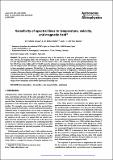Por favor, use este identificador para citar o enlazar a este item:
http://hdl.handle.net/10261/13527COMPARTIR / EXPORTAR:
 SHARE SHARE
 CORE
BASE CORE
BASE
|
|
| Visualizar otros formatos: MARC | Dublin Core | RDF | ORE | MODS | METS | DIDL | DATACITE | |

| Campo DC | Valor | Lengua/Idioma |
|---|---|---|
| dc.contributor.author | Cabrera Solana, Daniel | - |
| dc.contributor.author | Bellot Rubio, Luis R. | - |
| dc.contributor.author | Toro, José Carlos del | - |
| dc.date.accessioned | 2009-06-08T12:03:58Z | - |
| dc.date.available | 2009-06-08T12:03:58Z | - |
| dc.date.issued | 2005-08 | - |
| dc.identifier.citation | Astronomy and Astrophysics 439(2): 687-699 (2005) | en_US |
| dc.identifier.issn | 0004-6361 | - |
| dc.identifier.uri | http://hdl.handle.net/10261/13527 | - |
| dc.description | 13 pages, 11 figures, 1 table + Appendix A (3 suppl. tables). | en_US |
| dc.description.abstract | We present an analytical and numerical study of the sensitivity of weak solar photospheric lines to temperature, velocity, and magnetic fields. Our investigation is based on the concept of response functions (Landi degl'Innocenti & Landi degl'Innocenti 1977; Ruiz Cobo & del Toro Iniesta 1994). Lines commonly used in solar spectropolarimetry, like Fe(I) 630.25 nm in the visible and Fe(I) 1564.85 nm in the infrared, are examined in detail as emerging from reference quiet Sun and sunspot models. We develop a simple phenomenological model capable of describing the response of any given line to these atmospheric parameters. We find that: (a) the sensitivity of the lines to velocity and magnetic fields increases with the sharpness of the intensity and circular polarization profiles; (b) the sensitivity to temperature is determined mainly by the variation of the source function with temperature, which is smaller at longer wavelengths; and (c) lines quoted to be insensitive to temperature, like Fe(I) 1564.85 nm and Fe(I) 557.61 nm, exhibit larger changes in equivalent width than lines presumed to have higher sensitivities to T, such as Fe(I) 630.25 nm. The relations provided by our model are universal and can be used to decide which line is better suited to measuring a given atmospheric parameter. The results of this study are of practical interest for the design of new instruments and for better exploitation of existing ones. | en_US |
| dc.description.sponsorship | This work was supported by the Programa Ramón y Cajal of the Spanish Ministerio de Educación y Ciencia, project AyA2001-1649 of the Spanish Programa Nacional de Astronomía y Astrofísica, and projects ESP2002-04256-C04-01 and ESP2003-07735-C04-03 of the Programa Nacional del Espacio, partly using European FEDER funds. | en_US |
| dc.format.extent | 448390 bytes | - |
| dc.format.mimetype | application/pdf | - |
| dc.language.iso | eng | en_US |
| dc.publisher | EDP Sciences | en_US |
| dc.rights | openAccess | en_US |
| dc.subject | Sun: photosphere | en_US |
| dc.subject | Line: profiles | en_US |
| dc.subject | Sun: magnetic fields | en_US |
| dc.subject | Polarization | en_US |
| dc.title | Sensitivity of spectral lines to temperature, velocity, and magnetic field | en_US |
| dc.type | artículo | en_US |
| dc.identifier.doi | 10.1051/0004-6361:20052720 | - |
| dc.description.peerreviewed | Peer reviewed | en_US |
| dc.relation.publisherversion | http://dx.doi.org/10.1051/0004-6361:20052720 | en_US |
| dc.type.coar | http://purl.org/coar/resource_type/c_6501 | es_ES |
| item.fulltext | With Fulltext | - |
| item.languageiso639-1 | en | - |
| item.openairecristype | http://purl.org/coar/resource_type/c_18cf | - |
| item.openairetype | artículo | - |
| item.cerifentitytype | Publications | - |
| item.grantfulltext | open | - |
| Aparece en las colecciones: | (IAA) Artículos | |
Ficheros en este ítem:
| Fichero | Descripción | Tamaño | Formato | |
|---|---|---|---|---|
| Cabrera_et_al_A&A_439_2005.pdf | 437,88 kB | Adobe PDF |  Visualizar/Abrir |
CORE Recommender
SCOPUSTM
Citations
67
checked on 22-abr-2024
WEB OF SCIENCETM
Citations
73
checked on 24-feb-2024
Page view(s)
417
checked on 24-abr-2024
Download(s)
351
checked on 24-abr-2024
Google ScholarTM
Check
Altmetric
Altmetric
NOTA: Los ítems de Digital.CSIC están protegidos por copyright, con todos los derechos reservados, a menos que se indique lo contrario.
